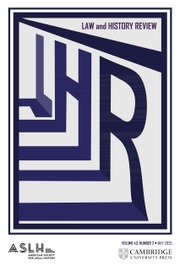No CrossRef data available.
Article contents
Extending the Revisionist Project
Published online by Cambridge University Press: 28 October 2011
Extract
I am gratified by Stephen Siegel's generous analysis of my article and its place within the historiography of Gilded Age legal thought. In his comment, Siegel has performed the invaluable task of synthesizing the various strands of revisionist scholarship in this area and examining the growing body of, in his apt words, “revisions of the revision.” It should be noted that Siegel himself is at the forefront of the current wave of scholarship he describes. If Langdell is eventually ousted from his current position as the leading exemplar of late nineteenth-century private law jurisprudence, Siegel's seminal and sophisticated work, to which I am much indebted, will deserve much of the credit.
- Type
- Forum: Response
- Information
- Copyright
- Copyright © the American Society for Legal History, Inc. 2002
References
1. See Grossman, Lewis, “James Carter Coolidge and Mugwump Justice,” Law and History Review 20 (2002): 541–629CrossRefGoogle Scholar, and Stephen A. Siegel, “The Revision Thickens,” ibid., 631–37.
2. Siegel, “The Revision Thickens,” 636, n. 23.
3. For Carter's support of Langdell, see LaPiana, William P., Logic and Experience (New York: Oxford University Press, 1994), 12–13Google Scholar; Harvard Law School Association, Report of the Organization and of the First General Meeting at Cambridge, November 5, 1886 (Boston, 1887), 25–28.
4. The phrase “determinate geometric order” is borrowed from Thomas C. Grey, “Lang-dell's Orthodoxy,” University of Pittsburgh Law Review 45 (1983): 32.
5. Kennedy, Duncan, “Toward an Historical Understanding of Legal Consciousness: The Case of Classical Legal Thought in America, 1850–1940,” Research in Law and Sociology 3 (1980): 20–21.Google Scholar
6. Carter, James Coolidge, Law: Its Origin, Growth, and Function (New York: G.P. Putnam's Sons, 1907), 135.Google Scholar
7. See Siegel, Stephen A., “Historism in Late Nineteenth- Century Constitutional Thought,” Wisconsin Law Review (1990): 1431–1547.Google Scholar The jurists Siegel discusses in this article are John Norton Pomeroy, Thomas Cooley, and Christopher Tiedemann. Siegel also identifies John Chipman Gray as a “historist.” Siegel, Stephen A., “John Chipman Gray and the Moral Basis of Classical Legal Thought,” Iowa Law Review 86 (2001): 1589–90.Google Scholar
8. Siegel, Stephen A., “Joel Bishop's Orthodoxy,” Law and History Review 13 (1995): 254–55.CrossRefGoogle Scholar


